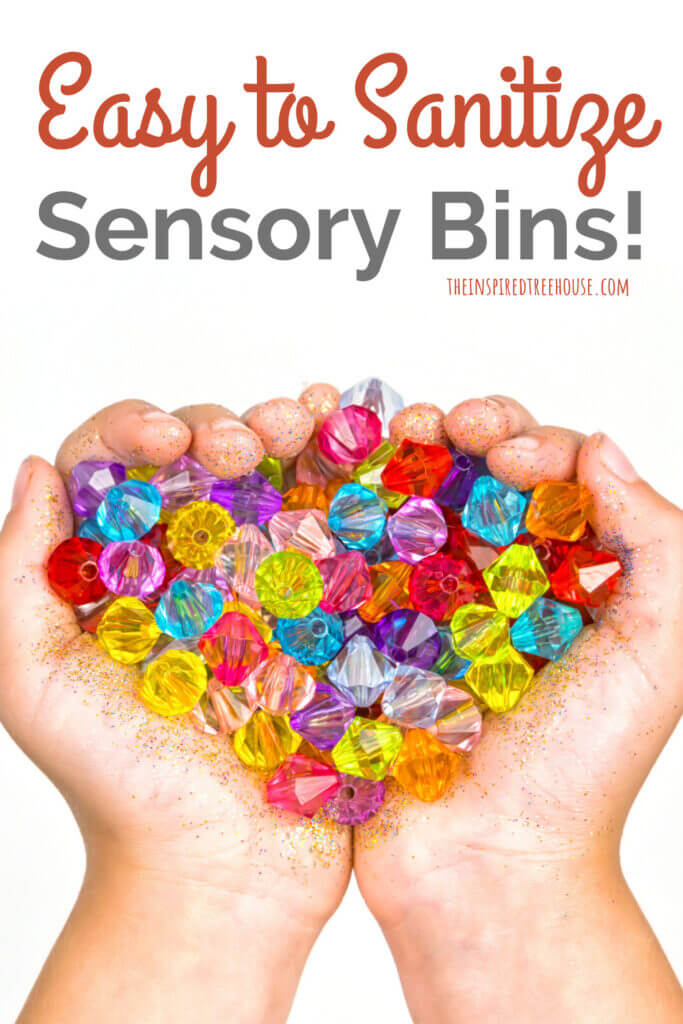Check out some of our favorite sensory bins that are easy to clean and change out to avoid spreading germs!
*This post contains affiliate links. Read more.
An integral part of our in-person playgroups at our non-profit, The Treehouse, is the sensory bin. Each week, we create a unique sensory play experience that welcomes kids into the space at the start of their playgroup. This sensory bin provides an opportunity for socialization, peer cooperation, self-regulation, conflict resolution and the obvious fine and sensory motor skill building.
Typically, we stock a large plastic container with the usual sensory bin fillers (rice and beans are favorites). Then, we add in props that make sense for the theme of the week. For instance, if the theme is Spiders, we might fill the container with black beans and add in plastic spiders, tiny erasers, and maybe some tongs and tweezers to “capture” them. We always have some cups for pouring and transferring to maximize bilateral coordination practice and ice cube trays are also a common element for kids to fill or categorize their findings.
Want to help kids learn more about their sensory systems? Check out this Five Senses Lapbook for Preschool!
Sensory Bin Changes
The pandemic required us to think a little differently about sensory bins. This type of hands-on play activity is problematic, considering the potential for many little hands to touch the materials throughout a day. Even now, with the worst of the COVID-19 pandemic behind us, we want to make sure that we’re not spreading germs during sensory play.
How can we ensure the health and safety of our kids and staff by reducing germs being spread between groups? Don’t worry. We’re on it!
Easy to Sanitize Sensory Bins
Here are some of our best ideas for sensory bin fillers that will help you as you head back into your clinic or the schools this fall. All of us will have to be extra cautious for the foreseeable future.
This list contains items that are either quickly sanitized between sessions or items that can be thrown away between sessions and replaced very easily and cost effectively.
Quickly sanitized items:
Marbles
Stones
Beads (add different shapes and sizes)
Puzzle Pieces and Puzzle Boards
Squigz
MagnaTiles
Wood Blocks
Plastic Toys/Animals/Bugs/Action Figures
Legos
Unifix Cubes
Letter or number magnets/manipulatives
Buttons
Cooking utensils and water
Nuts, bolts, and washers (add string to see if kids can thread the hardware on to make bracelets)
*Many of these options can be combined with water to add even more novelty and interest! Check out this post for one idea!
Items that can easily be replaced between sessions:
Shredded Paper or Easter basket grass
Soapy Water
Pasta
Leaves (provide paper and glue so kids can create their own leaf masterpieces)
Sticks (add rubber bands and/or yarn to see what kids can create)
Flowers (add scissors and glue so kids can cut up petals to create colorful mosaics)
Cotton Balls
Shaving Cream
Ice
Acorns and pinecones
For more ways to combine different sensory bin fillers and more ideas for fun and unique sensory bin add-ons – check out this post!
*Always be mindful of the child that will be using the sensory bin and don’t use items that may be easily swallowed or choked on if the child is still mouthing items or is an oral sensory seeker.
*Always have kids wash hands or use hand sanitizer before and after playing in any sensory bin!
*Be sure to discard or disinfect any sensory bin item that a child places in his mouth or near his face.

Latest posts by Lauren Drobnjak (see all)
- End of the Year Gifts for Therapists - April 14, 2024
- Playful Therapy Posters to Spruce Up Your Room - March 30, 2024
- How to Help a Baby Crawl & Creative Crawling Patterns We See in Therapy - March 19, 2024

